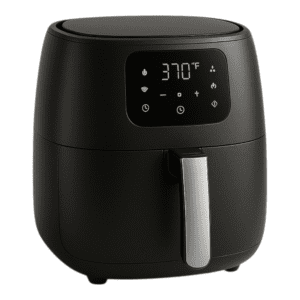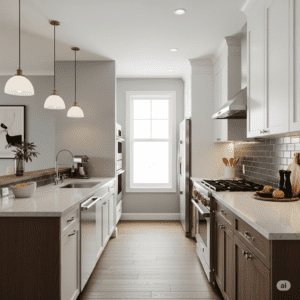The right kitchen trash cans can change your daily cooking and cleaning routine for the better. These indispensable waste bins take care of any garbage you need to dispose of in your kitchen. The best trash can is tough, convenient, and will look great in your kitchen.
The best kitchen trash cans available today deliver hands-free operation, odor control, and space-efficient shapes. Whether you’re looking for a small trash can that you can tuck away in a bathroom or a large trash can for your garage or backyard, the right model will make trash and recycling a cinch.
Why Quality Home Kitchen Trash Cans Matter
The right trash can should do more than keep trash out of sight. Good kitchen trash cans will promote cleanliness by keeping odors where they belong, and preventing garbage spills. And they look great in your kitchen while keeping functional and organized during the day.
Cheap trash cans tend to fall apart under daily use. In the meantime, quality models decades old hold up their performance and their looks.
Health and Hygiene Benefits
Good kitchen trash cans have snug-fitting lids that keep odors contained. This will keep bad odors from being distributed throughout your house. High quality waste bins are also bacteria resistant and can be cleaned with regular household chemicals.
Some designs even have built in antimicrobial coatings that limit the growth of harmful bacteria. These qualities protect the health of your family and preserve the air quality in your kitchen.
Space Efficiency and Organization
Intelligent trash can designs make the most of the available space in your kitchen. Under-cabinet models stow neatly away, and corner units take advantage of normally wasted space. Double-compartment waste bins allow you to keep regular trash and recycling in the same area without using multiple containers.
Good kitchen organization begins with containing the trash. The proper placement of a trash can is not only convenient but an easy way to keep the surrounding area clean and working smoothly.
What to Consider While Buying Kitchen Trash Cans?
Contemporary trash cans are equipped with features that provide convenience and functionality. Understanding these choices enables you to select the best trash can to meet your particular requirements.
Hands-Free Operation
No-touch kitchen trash cans open via motion detectors or foot pedals. This function is specifically useful when cooking and your hands are dirty or occupied.
Automatic models sense the movement and open and close automatically. A step-on version simply requires a foot tap to open its lid. Both are options that reduce contamination and increase hygiene in the kitchen.
Odor Control Technology
High-end garbage pails have odor control mechanisms, such as carbon filters or specially designed lid seals. These features help trap undesirable odors, for a fresh and clean kitchen between bag changes.
Some models have replacement odor filters that trap smells for a number of months. Others utilize special lid designs that form a tight seal when closed.
Size and Capacity Options
Kitchen trash cans range from small 2-gallon models to larger 20-gallon versions. The most suitable capacity depends on your household size and waste amount. Families who are on the smaller side usually use 8-12 gallon trash cans, while people with bigger families are better off with 13-16 gallon bins.
Take note of your trash pickup day when selecting size. With once-weekly pickup comes smaller garbage cans, less frequent service necessitates larger-capacity wastebaskets.
Best Kitchen Trash Cans for Every Budget and Need
These five models, which we found in our own research and testing, are the best we’ve found because they offer great quality and features for a reasonable price. Every trash can has its own standout feature and offers consistent performance in waste disposal. For more quality home and kitchen products, check out our full selection.
SimpleHuman 45-Liter Rectangular Step Can
This high quality rubbish bin with its clever design and exclusive look will not only look good, but even does a good job. Heavy-gauge steel makes this can dent-resistant, and the stainless steel foot pedal unlocks the specially designed track to prevent bag from snagging and the lid from bumping.
Key Features:
- Stainless steel construction resists fingerprints
- Solid steel pedal activation for reliable and easy activation every time
- Liner pocket for custom fit liner, no bags overhang the rim
- Lid shox technology provides a slow, silent close
- Capacity: 45 Liter (12 gallon), suitable for most families
The SimpleHuman option has a higher initial price, but better durability and a more stylish design. Its rectangular design fits efficiently into walls or corners.
iTouchless 13-Gallon Sensor Trash Can
This touchless trash can opens with a simple wave of your hand. The infrared sensor reacts fast and the capacity of the trashcan can also accommodate a lot of garbage.
Key Features:
- Hands free operation with motion sensor technology
- Holds up to 13 gallons, big enough for the average family
- Works with an AC adapter or batteries
- Odor filter compartment for additional freshness
- Easy-to-clean plastic construction
For families seeking touchless convenience, the iTouchless model offers great value. Its accurate sensor is always steady with no false alarms.
Rubbermaid Step-On Wastebasket
The price is reasonable, and it performs the basic function without any frills. It is durable and resists everyday wear and tear, and the step-on function is easy to use.
Key Features:
- Durable plastic construction resists cracks
- Non-skid bottom keeps it in place while using
- Easy-lift removable liner bucket
- 13-gallon capacity fits standard bags
- Budget-friendly price point
This basic trash bin design will allow you to maintain your kitchen clear and waste in its place. Rubbermaid’s high-quality standard is evident in this simple garbage can design. Doesn’t have fancy extras but it does what it does well.
Simplehuman Dual Compartment Recycling Can
This nifty waste bin has separate sections for rubbish and recycling. The double-end design allows you to separate two types of waste at the same time without combining them.
Key Features:
- Two 20-liter compartments for waste separation
- Color-coded lids prevent confusion
- Inner buckets are removable for easy emptying
- Space-efficient vertical design
- Durable steel construction
Ideal for eco-friendly households, this trash can makes recycling easy while saving floor space.
SONGMICS Under-Cabinet Trash Can
This compact, space efficient design waste bin hangs easily on the back of your cabinet door to offer space to throw garbage away. The flip top sliding feature allows easy access to your trash compartment while keeping the garbage can hidden.
Key Features:
- Under-cabinet mounting saves floor space
- Smooth sliding rail system
- 2.6-gallon capacity is perfect for small kitchens
- Easy installation with included hardware
- Removable inner bucket for cleaning
Perfect for small kitchens or as a second waste bin, this model is efficient with space.
Comparing Kitchen Trash Can Types and Durability
Various materials have their unique pros and cons for kitchen trash cans. If you know the alternatives, you can select the perfect waste bin for your requirements and your budget.
Stainless Steel Advantages
The stainless steel trash cans are corrosion proof, stain and dent resistant. They also clean easily and hold up well. But these models are generally pricier than their plastic counterparts.
Stainless steel garbage cans with brushed finishes help to hide fingerprints and scratches. Some offer resistant finishes that provide added strength and beauty.
Plastic Benefits and Limitations
Plastic kitchen trash cans are less expensive and lightweight so you can move them around with ease. Current high-density plastic is crack resistant and durable. But they can hold onto odors, and as they wear, they will do so more quickly than steel models.
Better plastic waste bins feature reinforced stress points and thick exterior UV coating. They keep the structure strong and make the life span longer.
Composite Material Innovations
Other brands go for a mix of materials for optimum performance. These fusion trash cans may have stainless steel frames and plastic parts, or chrome trim on largely plastic bodies.
Composites are a design trade-off between cost, durability and meeting a required function. They often give benefits greater than pure steel models, hosting better plastic-like performance.
How to Pick the Right Size Waste Container
The appropriate trash can size varies based on household size, amount of waste, and how often the trash is picked up. This guide can help you match capacity to your particular needs.
Standard Trash Can Size Comparisons
| Household Size | Recommended Size | Pickup Frequency |
|---|---|---|
| 1-2 people | 8-10 gallons | Weekly |
| 3-4 people | 11-13 gallons | Weekly |
| 5+ people | 14-16 gallons | Weekly |
| Any size | 6-8 gallons | Twice weekly |
Small Kitchen Considerations
Small kitchens do well with small trash bins that won’t crowd the room. Look at under-cabinet models or slim versions that can squeeze into tight spots.
Several small trash cans are often more effective than one large one in close quarters. They are also at the ready around food preparation and eating areas.
Large Family Requirements
Larger families will generate more waste, and will therefore require larger kitchen trash cans. Search for models that feature reinforced construction to support extra weight and volume.
Think about double trash cans with compartments that divide regular trash from recycling. This procedure deals with large quantities and has an environmentally-friendly attitude.

Tips on How to Setup and Place a Kitchen Trash Can
Placing it correctly ensures convenient use as well as looks in your kitchen. Factor in traffic patterns and work zones, and accessibility, when you place your garbage can.
Optimal Location Strategy
Position kitchen trash cans in convenient locations such as close to main food prep spaces for easy access while cooking. Stay away from areas that will obstruct cabinet doors or any appliances.
Typically works well in corners, making effective use of space that would otherwise be wasted. Keep the lid opening and bag removing from being obstructed.
Workflow Integration
Place waste bins where natural work flows are encouraged. Install them between the sink and primary preparation space to facilitate quick disposal during food preparation and after meals.
Large kitchens may be better served by multiple smaller garbage cans placed in various locations rather than a single central unit. Store them where you use them and where there is enough room.
Safety and Accessibility
Be certain that kitchen garbage cans won’t obstruct emergency exits or create a tripping hazard. Select stable models that can’t easily tip over during typical use.
Take into consideration family members with mobility issues when determining the height and method of operation. Step-on models can get challenging to operate for some of your users, while sensor-activated trash cans provide accessibility to all.
Maintenance and Cleaning Best Practices
Routine upkeep keeps kitchen garbage cans sanitary and increases their life. Easy cleaning processes eliminate odors and bacteria.
Daily Care Routines
Regularly replace the garbage, to avoid it from overflowing and the stench lingering. Use disinfectant wipes or a mild detergent wipe to clean hard surfaces on the outside of the product every day.
Check lid seals every week, and clean, if needed, to ensure an odor-tight seal. Change odor filters as directed by the manufacturer.
Deep Cleaning Methods
Regular deep cleaning processes at intervals ensure the complete removal of dirt and sanitize the waste bin surfaces. For complete sanitation, use mild bleach solutions or commercial disinfectants.
Remove and wash detachable parts separately for thorough cleaning. Make sure all the pieces have dried thoroughly before putting them back together to avoid the growth of mold.
Troubleshooting Common Issues
Sensors in automated trash cans sometimes refuse to work because dirt or scraps cover the detection area. Wipe sensors clean periodically using soft, dry cloths.
The pedal may seize due to debris build-up. Apply suitable lubricants to moving parts every year to ensure their continued smooth operation.
Budget Considerations and Value Analysis
Kitchen trash cans vary from inexpensive simple ones to high-cost and complex. Knowing value propositions helps you to buy wisely.
Initial Cost vs. Long-Term Value
More expensive trash cans tend to be more durable and feature-rich. Include cost of ownership, replacement rate, and maintenance.
Quality waste bins may cost three times as much at the front end but last five times as long as budget options. This calculation is a proponent of quality-built for the long term.
Feature Priority Assessment
Make sure to put your wishlist of features in priority order to help you form a better opinion on what to buy. Performance related features should be given more importance than convenience features such as dependable operation and enough capacity.
Higher-end features such as sensors or odor control add value to some users, but some may not need them. Be honest with yourself about your actual needs – you could end up saving a lot of money.
Environmental Impact and Sustainability
Selecting eco-friendly kitchen trash cans is a great option for meeting your sustainability targets and for effectively disposing of household waste. Think about material origins, lifespan and disposal. For more sustainable living tips and products, check out Good Housekeeping’s sustainability guide.
Eco-Friendly Material Options
Some trash cans are made from recycled materials. These components have lower environmental impact and similar properties as those based on virgin materials.
Search for certifications for sustainable production processes or biodegradable materials.
Waste Reduction Strategies
Twin-bucket trash cans for separating trash and recyclables. This characteristic contributes to reducing the total volume of waste and environmental awareness.
The composting function of certain kitchen trash cans further cuts off organic waste disposal demands. These are in line with the principles of sustainable living.
Frequently Asked Questions (FAQs)
What size is the best kitchen trash can size for a family of four?
A 12-13 gallon trash can generally fits four people and is used for once a week pickup service. It has ample storage space for everyday household waste with no need for daily emptying between pickups.
How often should I change my kitchen trash can?
Good quality rubbish bins should last between 3 to 5 years on average so long as they are maintained. Replace anytime structural damage occurs, internal mechanisms begin to fail repeatedly, or it’s no longer possible to get the can clean due to old, sticky residue permanently stuck to it.
Are stainless steel, sensor-activated kitchen trash cans really worth it?
Some users find the convenience and aesthetic benefits of sensor models to be worth the high cost. But they run on electricity and can break down. Take into account what you care about and how you’ll use your device.
Tips on getting kitchen trash cans to smell better?
Cover with tight-fitting lids, empty frequently and clean often to avoid odors. Look for options that have built-in odor filters or add some baking soda to help absorb nasty smells the natural way.
Am I able to use standard trash bags in a specialized kitchen trash can?
Most trash cans will fit standard bags, though some will perform best when used with a certain size of bag or a custom fit liner. Refer to manufacturer recommendations for best results for performance and appearance.
How can I keep my kitchen garbage can from sliding all over the place?
Opt for models with non-slip bases or place rubber pads at the bottom. Heavier construction also means less movement when in use. Certain garbage bins have weighted bases for added stability.
Do I want a hands-free or step-on kitchen trash can?
They both have touchless operation but with different methods. Step-on models are more reliable and don’t need power, while sensor ones are pure hands-free convenience. Think about what would work best for you and your kitchen.
Final Thought: The Best of the Best for Your Kitchen
Choosing the best kitchen trash cans involves finding containers with the right blend of function, durability and budget. Five models are presented which are representative of distinct waste management strategies, and have a particular strong aspect that distinguishes them from the others.
When deciding, take into account your family size, the available space and the features you’re looking for. Don’t forget that the best garbage can lasts a long time, and improves the efficiency and décor of your kitchen.
The monthly savings in terms of convenience, cleanliness, and restocking costs, add up to a well-designed wastebasket. Take a little bit of time to consider what exactly you need and select a kitchen garbage can that will serve your family well for decades to come.
Whether you like the premium build quality of SimpleHuman or you’d like the convenient, hands-free motion of a sensor model, or the space-saving functionality of under-the-counter options, the appropriate trash can facilitates waste disposal and helps ensure your kitchen is clean and your cooking arrangements tidy.



